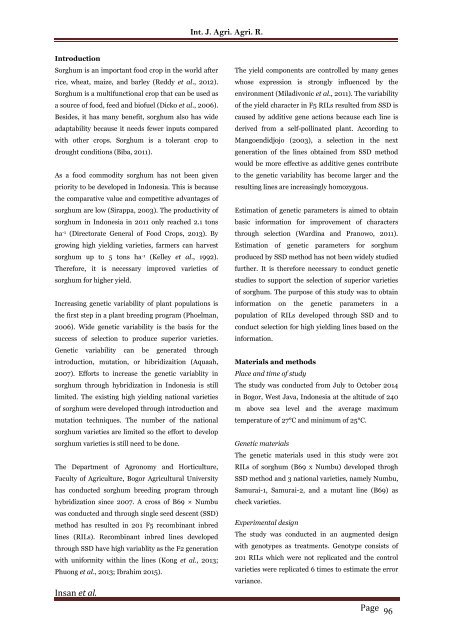IJAAR-V8No2-p95-103
Create successful ePaper yourself
Turn your PDF publications into a flip-book with our unique Google optimized e-Paper software.
Int. J. Agri. Agri. R.<br />
Introduction<br />
Sorghum is an important food crop in the world after<br />
rice, wheat, maize, and barley (Reddy et al., 2012).<br />
Sorghum is a multifunctional crop that can be used as<br />
a source of food, feed and biofuel (Dicko et al., 2006).<br />
Besides, it has many benefit, sorghum also has wide<br />
adaptability because it needs fewer inputs compared<br />
with other crops. Sorghum is a tolerant crop to<br />
drought conditions (Biba, 2011).<br />
As a food commodity sorghum has not been given<br />
priority to be developed in Indonesia. This is because<br />
the comparative value and competitive advantages of<br />
sorghum are low (Sirappa, 2003). The productivity of<br />
sorghum in Indonesia in 2011 only reached 2.1 tons<br />
ha -1 (Directorate General of Food Crops, 2013). By<br />
growing high yielding varieties, farmers can harvest<br />
sorghum up to 5 tons ha -1 (Kelley et al., 1992).<br />
Therefore, it is necessary improved varieties of<br />
sorghum for higher yield.<br />
Increasing genetic variability of plant populations is<br />
the first step in a plant breeding program (Phoelman,<br />
2006). Wide genetic variability is the basis for the<br />
success of selection to produce superior varieties.<br />
Genetic variability can be generated through<br />
introduction, mutation, or hibridizaition (Aquaah,<br />
2007). Efforts to increase the genetic variablity in<br />
sorghum through hybridization in Indonesia is still<br />
limited. The existing high yielding national varieties<br />
of sorghum were developed through introduction and<br />
mutation techniques. The number of the national<br />
sorghum varieties are limited so the effort to develop<br />
sorghum varieties is still need to be done.<br />
The Department of Agronomy and Horticulture,<br />
Faculty of Agriculture, Bogor Agricultural University<br />
has conducted sorghum breeding program through<br />
hybridization since 2007. A cross of B69 × Numbu<br />
was conducted and through single seed descent (SSD)<br />
method has resulted in 201 F5 recombinant inbred<br />
lines (RILs). Recombinant inbred lines developed<br />
through SSD have high variablity as the F2 generation<br />
with uniformity within the lines (Kong et al., 2013;<br />
Phuong et al., 2013; Ibrahim 2015).<br />
Insan et al.<br />
The yield components are controlled by many genes<br />
whose expression is strongly influenced by the<br />
environment (Miladivonic et al., 2011). The variability<br />
of the yield character in F5 RILs resulted from SSD is<br />
caused by additive gene actions because each line is<br />
derived from a self-pollinated plant. According to<br />
Mangoendidjojo (2003), a selection in the next<br />
generation of the lines obtained from SSD method<br />
would be more effective as additive genes contribute<br />
to the genetic variability has become larger and the<br />
resulting lines are increasingly homozygous.<br />
Estimation of genetic parameters is aimed to obtain<br />
basic information for improvement of characters<br />
through selection (Wardina and Pranowo, 2011).<br />
Estimation of genetic parameters for sorghum<br />
produced by SSD method has not been widely studied<br />
further. It is therefore necessary to conduct genetic<br />
studies to support the selection of superior varieties<br />
of sorghum. The purpose of this study was to obtain<br />
information on the genetic parameters in a<br />
population of RILs developed through SSD and to<br />
conduct selection for high yielding lines based on the<br />
information.<br />
Materials and methods<br />
Place and time of study<br />
The study was conducted from July to October 2014<br />
in Bogor, West Java, Indonesia at the altitude of 240<br />
m above sea level and the average maximum<br />
temperature of 27°C and minimum of 25°C.<br />
Genetic materials<br />
The genetic materials used in this study were 201<br />
RILs of sorghum (B69 x Numbu) developed throgh<br />
SSD method and 3 national varieties, namely Numbu,<br />
Samurai-1, Samurai-2, and a mutant line (B69) as<br />
check varieties.<br />
Experimental design<br />
The study was conducted in an augmented design<br />
with genotypes as treatments. Genotype consists of<br />
201 RILs which were not replicated and the control<br />
varieties were replicated 6 times to estimate the error<br />
variance.<br />
Page 96


















